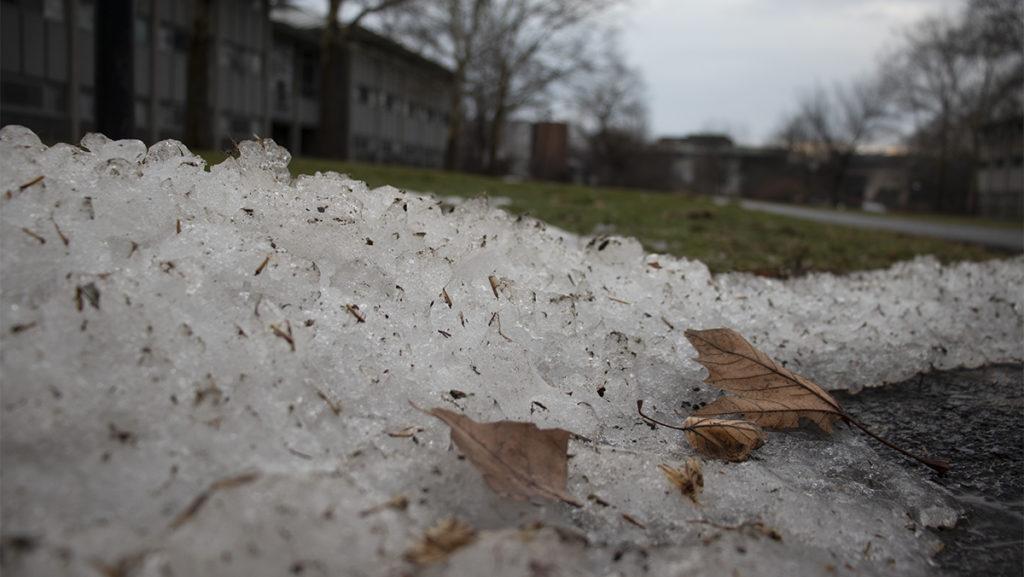Different regions of New York have experienced varying amounts of snow and weather patterns this winter, partially because of a La Niña winter and milder temperatures. However, despite consistent snowfall in Ithaca, other factors indicate climate change in the area.
According to an article by The Ithacan from April 2022, Rebecca Evans, acting director of Sustainability for the City of Ithaca, explained that the specific concerns for Ithaca include flooding and droughts. This is because the city is built around 150 waterfalls, making the city an easy target for flooding. Ithaca primarily floods from Fall Creek, which leads to a waterfall close to downtown Ithaca. According to the Ithaca Voice, in 2021, Fall Creek rose to 5.27 feet. In 1971, Fall Creek reached levels of 11.27 feet.
According to the Northeast Regional Climate Center, Ithaca receives on average 62.9 inches of snowfall on an annual basis. However, according to the Cornell Daily Sun, in 2021, the same year as the flood at Fall Creek, Ithaca received snow two weeks later than the prior year, which was a marker for climate change.
The lack of snow observed in southern New York is known as a snow drought. According to the National Integrated Drought Information System, a snow drought means there are unusually small amounts of measurable snow for the winter months.
Art DeGaetano, director of the Northeast Regional Climate Center and professor of Earth and Atmospheric Sciences at Cornell University, looked at data records from the National Oceanic and Atmospheric Administration to determine the differences in snowfall in Central Park from 1870 to 2023.
“If I look at the total amount of snow that has fallen between July 1 and [Feb. 7, 2023], this is the lowest total snowfall New York City has ever had,” DeGaetano said. “[In New York City], it’s a little bit more pronounced than it is [in Ithaca]. They’ve had .04 inches. There have been only three years that they have had less than an inch between the start of the snow season and now.”
DeGaetano also looked at the NOAA data for Ithaca and was able to see the amount of snow droughts Ithaca has had. He said that there have not been very many and that Ithaca is low on the list for being a common place for snow droughts and is currently not experiencing a snow drought.
“I wouldn’t say snow droughts are common in New York,” DeGaetano said. “If I look back at the historical record for Ithaca, which has a 100–year record, we were probably about the 10th lowest on record.”
DeGaetano said snow droughts are difficult to predict and more dangerous than water droughts since snowpack melts and fills reservoirs needed for drinking water in the spring and summer months.
Scott Doyle, Ithaca College’s director of Energy Management and Sustainability, said that because of warmer temperatures, rain will be more likely than snow in New York City and that quite a bit of rain is expected for the spring months, indicative of climate change. According to the Farmer’s Almanac, the rest of Ithaca’s winter is expected to be colder than normal with above-normal snowfall, while Ithaca’s spring months are expected to have above-normal precipitation.
Doyle said the snowfall in Ithaca has been much more consistent and far heavier than that of New York City’s. Doyle said this is most likely because winters in downstate New York have lower elevation, lower latitude and are closer to the Atlantic Ocean, making winters much more mild than upstate New York. He compared the two cities and the snowfall in each one, indicating that safety is always a high priority in the winter months.
“New York City usually has staff that takes a long time to remove snow and eventually just pushes it off … the coastline,” Doyle said. “That is a very important piece of the winter months, having to budget for salt and other aspects of safety. On campus, we have a good supply of resources for snow management and making the campus safer.”
According to the Proceedings of the National Academy of Sciences of the U.S., some causes of snow droughts include atmospheric circulation patterns, polar vortex movement and Arctic warming. Snow droughts occur all over the world, including parts of the U.S., especially in the Western portion of the country. Snow droughts in California were what caused the wildfires during September 2022.
Eric Leibensperger, assistant professor of Physics and Astronomy at the college, specializes in environmental physics, climate change and air quality. He said via email that man-made — also called anthropogenic — causes contributed to the snow drought in New York City. He said the conditions for a snow storm include temperatures at or below freezing and high levels of moisture in the air. However, he said these did not occur this winter in southern New York.
“Anthropogenic climate change has warmed our oceans and the Great Lakes and increased the supply of moisture,” Leibensperger said via email. “For much of the northeastern U.S., moisture is rarely the missing ingredient these days. Instead, [downstate’s] relatively warm winter is to blame.”
According to Weather Spark, the first snow in Ithaca 20 years ago occurred in October, while the first snowfall in 2022 occurred in November. This gap of one month between 2003 and 2022 explains how atmospheric temperatures are slowly rising in Ithaca.
DeGaetano said there has been an increase in low pressure centers this season, which is one cause for the snow drought. Low pressure centers are where atmospheric pressure is lower than its surroundings. When pressure centers move, this movement is called tracking. DeGaetano said La Niña winters can cause low pressure centers in New York City.
“La Niña is something that occurs way out in the Pacific Ocean, but it does affect the way that jet streams and the upper level winds blow over the United States,” DeGaetano said. “More often than not, during a La Niña winter, you do see storms track to the west of New York, up the Ohio Valley, which seems to be the preferred storm track during La Niña winters.”
However, DeGaetano said the leading cause for snow droughts are humans, since humans have contributed the most toward the warming of our atmosphere by use of fossil fuels.
“Back 50 years ago, I would say it was primarily due to things like La Niña,” DeGaetano said. “However, given the amount of climate change we’ve seen over the last 50 years, I would say human-induced climate changes is a big part of the picture, and particularly here in the Northeast.”
Leibensperger said via email that he had some concerns about hearing that there had been a snow drought in New York City, but is more concerned over the long term.
“The snow drought will have impacts that last into the summer,” Leibensperger said via email. “While this is concerning and at least partially due to natural fluctuations, I am always concerned about the long term shifts that we are seeing in our climate due to anthropogenic greenhouse gas emissions.”









